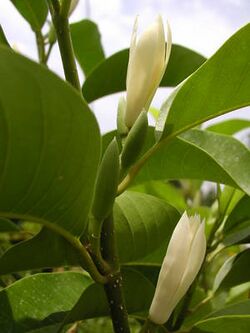Biology:Magnolia × alba
| White champaca | |
|---|---|

| |
| Scientific classification | |
| Kingdom: | Plantae |
| Clade: | Tracheophytes |
| Clade: | Angiosperms |
| Clade: | Magnoliids |
| Order: | Magnoliales |
| Family: | Magnoliaceae |
| Genus: | Magnolia |
| Subgenus: | Magnolia subg. Yulania |
| Section: | Magnolia sect. Michelia |
| Subsection: | Magnolia subsect. Michelia |
| Species: | M. × alba
|
| Binomial name | |
| Magnolia × alba | |
| Synonyms[2][3] | |
|
Michelia longifolia Blume | |
Magnolia × alba, also known as the white champaca, white sandalwood, or white jade orchid tree,[4] is a flowering plant of hybrid origin that is commonly cultivated in Southeast Asia and tropical regions of East Asia. Although the exact origin is uncertain, it is considered to be a hybrid of Magnolia champaca and Magnolia montana.[2]
Names
The current name of the white champaca is derived from its local name in Indonesian, Cempaka Putih.
The white champaca is known by various names in English including pak lan in Hawaii like Cantonese transcription of 白蘭. Horticultural trade names used in the United States include the taxonomic synonym Michelia alba to fanciful ones such as 'white fragrant himalayan champaca'.[5]
Names in other languages include kantil in Javanese.
In Taiwan, the tree and specifically the flower, is known as 玉蘭花 (yü lan hua).
Description
Magnolia × alba matures to 30 meters with evergreen leaves; the flowers have a count of 12 tepals.
Uses
Magnolia × alba is widely cultivated as an ornamental in Asia, particularly tropical and subtropical regions of China and Southeast Asia for the strongly fragrant flowers.[6]
In Taiwan, the flowers are plucked from trees before they open and bunches of them are strung together on wire, to be sold at roadside to truck and taxi drivers. The flowers remain fragrant for several days, before wilting and being disposed of.
In Indonesia, the pleasantly fragrant flower is used and arranged together with Jasminum sambac as flower garland, especially wore by brides during traditional wedding ceremony. The flowers are similarly used in Thailand, where they are worn as traditional wedding garlands by the bride and groom.
An essential oil is extracted from the flowers. In China , where it is known as bai lan (白蘭), the flowers are used to prepare yulan tea.[2] In traditional Chinese medicine, the flowers are used to move qi and relieve cough.[7]
Gallery
Several stages of the bud and flower; note: this image does not depict complete graduation
References
- ↑ Magnolia × alba was first identified and published in Proceedings of the International Symposium on the Family Magnoliaceae. Guangzhou, China 21. 2000 "Plant Name Details for Magnolia × alba". IPNI. http://www.ipni.org:80/ipni/idPlantNameSearch.do?id=20011680-1. "Hybrid Parentage: (Magnolia champaca (L.) Baill. ex Pierre × Magnolia montana (Blume) Figlar) ; Remarks: also published [later] by Figlar & Noot. in Blumea. 49(1): 96 (2004)"
- ↑ 2.0 2.1 2.2 2.3 {{citation | mode = cs1 | title = Magnolia × alba | work = Germplasm Resources Information Network (GRIN) | url = | publisher = [[Organization:Agricultural Research ServAgricultural Research Service (ARS), United States Department of Agriculture (USDA) | access-date = May 18, 2011 }}
- ↑ Govaerts, R., compiler; R.Figlar (2006), H.Nooteboom (1996), S.Spongberg (1996), reviewers. "Michelia × longifolia Blume". World Checklist of Magnoliaceae. The Board of Trustees of the Royal Botanic Gardens, Kew. Published on the Internet. http://apps.kew.org/wcsp/namedetail.do?name_id=126744.
- ↑ Hong Kong - Leisure and Cultural Services Department (2005). "Photo-Gallery Hong Kong Ornamental Plants". Greening Knowledge. http://www.lcsd.gov.hk/green/en/mial.php.
- ↑ "Monrovia (Plant Catalog)–White Fragrant Himalayan Champaca". Monrovia. 2015. http://www.monrovia.com/plant-catalog/plants/1847/white-fragrant-himalayan-champaca. "White Fragrant Himalayan Champaca Michelia champaca 'Alba'"
- ↑ Valder, Peter (1999), The garden plants of China, Timber Press
- ↑ Zhou, Jiaju; Xie, Guirong; Yan, Xinjian (2010), Encyclopedia of Traditional Chinese Medicines - Molecular Structures, Pharmacological Activities, Natural Sources and Applications: Isolated Compounds T-z, References for Isolated Compounds Tcm Original Plants and Congeners, China: Springer
External links
- Magnolia classification from the Magnolia Society.
Wikidata ☰ Q2221893 entry
 |






